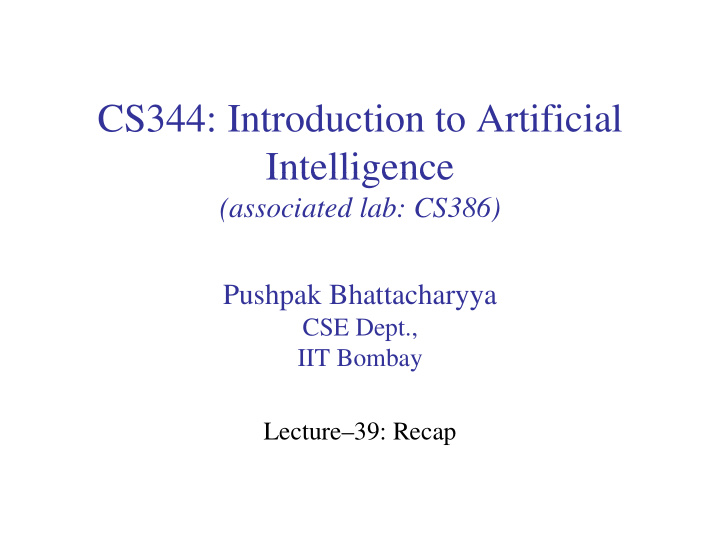



CS344: Introduction to Artificial Intelligence Intelligence (associated lab: CS386) Pushpak Bhattacharyya CSE Dept., IIT Bombay Lecture–39: Recap
Persons involved � Faculty instructor: Dr. Pushpak Bhattacharyya (www.cse.iitb.ac.in/~ pb) � TAs: Prashanth, Debraj, Ashutosh, Nirdesh, Raunak, Gourab { pkamle, debraj, ashu, nirdesh, rpilani, roygourab} @cse roygourab} @cse � Course home page � www.cse.iitb.ac.in/~ cs344-2010 (will be up) / ( p) � Venue: SIT Building: SIC301 � 1 hour lectures 3 times a week: Mon-11.30, Tue- 8.30, Thu-9.30 (slot 4) � Associated Lab: CS386- Monday 2-5 PM
Perspective Perspective
Disciplines which form the core of AI - inner circle Fields which draw from these disciplines- outer circle. Fields which draw from these disciplines- outer circle Robotics Robotics NLP Search, I R Reasoning, g, Expert Expert Learning Systems Planning Computer Computer Vision
Topics planned to be covered & actually covered (1/2) � Search � General Graph Search, A*: (yes) p , (y ) � Iterative Deepening, α - β pruning (yes in seminar) , probabilistic methods � Logic: � Formal System � Propositional Calculus, Predicate Calculus, Fuzzy P iti l C l l P di t C l l F Logic: (yes) � Knowledge Representation � Knowledge Representation � Predicate calculus: (yes) , Semantic Net, Frame � Script, Conceptual Dependency, Uncertainty p , p p y, y
Topics planned to be covered & actually covered (1/2) ( ) � Neural Networks: Perceptrons, Back Propagation, Self Organization � Statistical Methods � Markov Processes and Random Fields � Computer Vision, NLP (yes) , Machine Learning (yes) � Planning: Robotic Systems � Planning: Robotic Systems =================================(if possible) � Anthropomorphic Computing: Computational p p p g p Humour (yes in seminar) , Computational Music � IR and AI: (yes) � Semantic Web and Agents
Resources � Main Text: � Artificial Intelligence: A Modern Approach by Russell & Norvik, Pearson, 2003. Pearson, 2003. � Other Main References: � Principles of AI - Nilsson � AI - Rich & Knight AI Rich & Knight � Knowledge Based Systems – Mark Stefik � Journals � AI, AI Magazine, IEEE Expert, � Area Specific Journals e.g, Computational Linguistics � Conferences � IJCAI, AAAI
Foundational Points � Church Turing Hypothesis � Anything that is computable is computable � Anything that is computable is computable by a Turing Machine � Conversely, the set of functions computed Conversely, the set of functions computed by a Turing Machine is the set of ALL and ONLY computable functions
Turing Machine Finite State Head (CPU) Infinite Tape (Memory)
Foundational Points (contd) � Physical Symbol System Hypothesis (Newel and Simon) (Newel and Simon) � For Intelligence to emerge it is enough to manipulate symbols p y
Foundational Points (contd) � Society of Mind (Marvin Minsky) � Intelligence emerges from the interaction � Intelligence emerges from the interaction of very simple information processing units � Whole is larger than the sum of parts! Whole is larger than the sum of parts!
Foundational Points (contd) � Limits to computability � Halting problem: It is impossible to � Halting problem: It is impossible to construct a Universal Turing Machine that given any given pair < M, I> of Turing Machine M and input I, will decide if M halts on I � What this has to do with intelligent computation? Think!
Foundational Points (contd) � Limits to Automation � Godel Theorem: A “sufficiently powerful” � Godel Theorem: A sufficiently powerful formal system cannot be BOTH complete and consistent � “Sufficiently powerful”: at least as powerful as to be able to capture Peano’s Arithmetic � Sets limits to automation of reasoning
Foundational Points (contd) � Limits in terms of time and Space � NP-complete and NP-hard problems: Time � NP complete and NP hard problems: Time for computation becomes extremely large as the length of input increases � PSPACE complete : Space requirement becomes extremely large � Sets limits in terms of resources
Two broad divisions of Theoretical CS � Theory A � Algorithms and Complexity � Algorithms and Complexity � Theory B � Formal Systems and Logic Formal Systems and Logic
AI as the forcing function � Time sharing system in OS � Machine giving the illusion of attending g g g simultaneously with several people � Compilers � Raising the level of the machine for better man machine interface � Arose from Natural Language Processing A f N t l L P i (NLP) � NLP in turn called the forcing function for AI � NLP in turn called the forcing function for AI
Allied Disciplines Philosophy Knowledge Rep., Logic, Foundation of AI (is AI possible?) Maths h Search, Analysis of search algos, logic h l i f h l l i Economics Expert Systems, Decision Theory, P i Principles of Rational Behavior i l f R ti l B h i Psychology Behavioristic insights into AI programs Brain Science Learning, Neural Nets Physics Learning, Information Theory & AI, Entropy, Robotics Computer Sc. & Engg. Systems for AI
Grading � (i) Exams � Midsem � Endsem � Endsem � Class test � (ii) Study � Seminar (in group) S i (i ) � (iii) Work � Lab Assignments (cs386; in group)
Our work at IIT Bombay Our work at IIT Bombay
I R: I nformation Extraction: Cross Lingual Part of Speech tagging Search Named Entity Crawling Recognition I ndexing Shallow Parsing Multilingual Relevance Summarization Feedback Language P Processing & i & Understanding Machine Translation: Machine Learning: Statistical Semantic Role labeling I nterlingua Based Sentiment English � I ndian English � I ndian Analysis languages Text Entailment I ndian ( web 2.0 applications) languages � I ndian Using graphical models, support languages vector machines, neural networks I ndowordnet Resources: http://www.cfilt.iitb.ac.in Publications: http://www.cse.iitb.ac.in/~ pb
Recommend
More recommend